Dr. Oz's Beauty Book
By Dr. Mehmet Oz
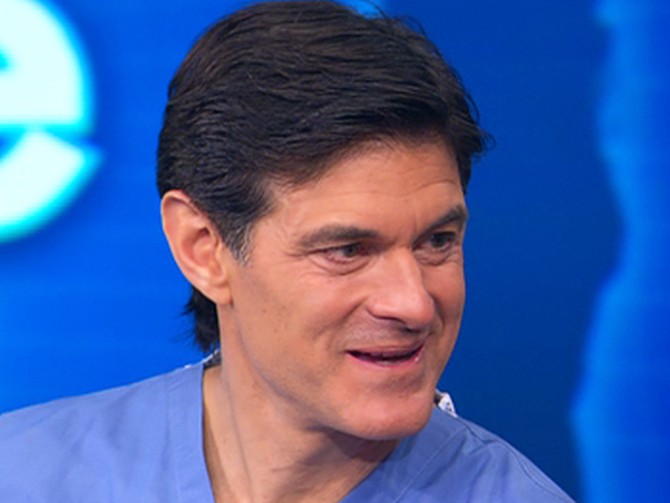
For their latest book, Dr. Oz and Dr. Michael Roizen are tackling a fundamental topic: beauty.
In YOU: Being Beautiful, they have sifted through decades of research, sought out the world's foremost experts and compiled everything we all need to know about how to look and feel more beautiful.
But their analysis is more than skin-deep. Dr. Oz says looking at appearance is actually our hardwired, instinctual way of determining the health and fertility of a potential partner. "Before you could draw someone's blood or look at their DNA or get an X-ray, we could—in a quarter of a second—look at each other and say, 'I want you to have my child,'" he says. "What that means to you is that you can find beauty immediately."
Dr. Oz says true beauty is about being healthy, both inside and out. "The real challenge for us," he says, "is to ... show you how to unveil the beauty that I know everybody has."
In YOU: Being Beautiful, they have sifted through decades of research, sought out the world's foremost experts and compiled everything we all need to know about how to look and feel more beautiful.
But their analysis is more than skin-deep. Dr. Oz says looking at appearance is actually our hardwired, instinctual way of determining the health and fertility of a potential partner. "Before you could draw someone's blood or look at their DNA or get an X-ray, we could—in a quarter of a second—look at each other and say, 'I want you to have my child,'" he says. "What that means to you is that you can find beauty immediately."
Dr. Oz says true beauty is about being healthy, both inside and out. "The real challenge for us," he says, "is to ... show you how to unveil the beauty that I know everybody has."

Joining Dr. Oz for his "beauty school" lesson is Harvard-trained dermatologist Dr. Susan Evans. She says people waste billions of dollars every year on skincare products and treatments that simply do not work.
Dr. Evans brought along a Visia Complexion Analysis System to get a closer look at what's going on with skin. "It actually uses ultraviolet and polarized light to look deep into the skin," she says. "It shows you things that you can't see with the visible eye [and] you can't see with a magnifying glass."
The machine takes two photos of a patient's skin. The first one is a highly magnified view of the visible skin—the epidermis—showing visible fine lines, wrinkles, pores and the brown spots and unevenness of skin damage.
The second photo goes even deeper, showing the dermis. This photo shows not what is, but will be—the indicators of sun damage that will lead to more wrinkles and brown spots in the next decade or so. "Sort of a normal progression if you've been out in the sun," Dr. Evans says.
Dr. Evans brought along a Visia Complexion Analysis System to get a closer look at what's going on with skin. "It actually uses ultraviolet and polarized light to look deep into the skin," she says. "It shows you things that you can't see with the visible eye [and] you can't see with a magnifying glass."
The machine takes two photos of a patient's skin. The first one is a highly magnified view of the visible skin—the epidermis—showing visible fine lines, wrinkles, pores and the brown spots and unevenness of skin damage.
The second photo goes even deeper, showing the dermis. This photo shows not what is, but will be—the indicators of sun damage that will lead to more wrinkles and brown spots in the next decade or so. "Sort of a normal progression if you've been out in the sun," Dr. Evans says.
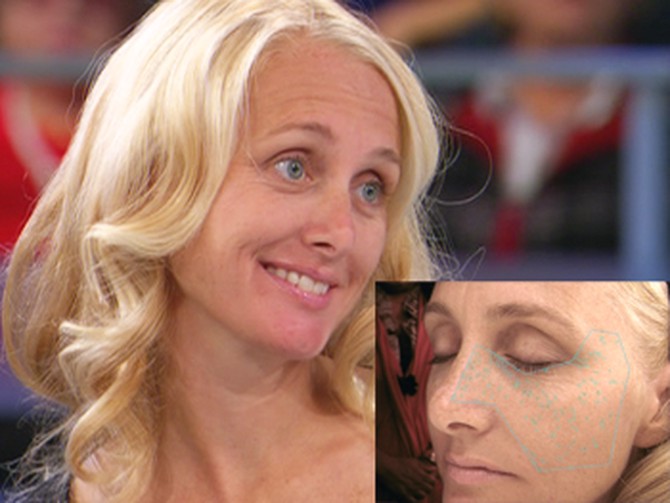
Meg is a 39-year-old mother of three and an avid surfer who admits to wearing as little sunblock as she can get away with—SPF 15 on her nose and under her eyes. "Because I want to look tan," she says. "I can't be in the water white."
Using the Visia Complexion Analysis System, Dr. Evans shows exactly the damage those years in the sun have caused. Her refusal to wear sunscreen and constant squinting will cause premature wrinkles, fine lines and uneven skin spots. "These things are going to come to the surface. She's going to have these age spots coming up everywhere," she says. "It doesn't mean that it's too far gone. I mean, you still have a beautiful face. It's just something that you should add to your program. It's great that you're here being concerned about it."
What can Meg do? Dr. Oz and Dr. Evans say she has to start wearing sunscreen made for active people on her face, body and hands. "Protect those areas that are getting a lot of sun exposure already," he says.
Using the Visia Complexion Analysis System, Dr. Evans shows exactly the damage those years in the sun have caused. Her refusal to wear sunscreen and constant squinting will cause premature wrinkles, fine lines and uneven skin spots. "These things are going to come to the surface. She's going to have these age spots coming up everywhere," she says. "It doesn't mean that it's too far gone. I mean, you still have a beautiful face. It's just something that you should add to your program. It's great that you're here being concerned about it."
What can Meg do? Dr. Oz and Dr. Evans say she has to start wearing sunscreen made for active people on her face, body and hands. "Protect those areas that are getting a lot of sun exposure already," he says.

Anita is 58 years old and cannot stand the brown spots that have started appearing on her face. What are they? Dr. Oz explains that skin has cells that secrete pigment—tanning is when those cells secrete more pigment. "But sometimes those pigments stain the skin, sort of like freckles," he says. "When you're older, they become sun spots. These are these brown spots."
Using the Visia Complexion Analysis System, Dr. Evans can tell that Anita has been wearing sunscreen. "I'm really pleased with that," she says. "But despite that, she has still seen some damage, and this has been going on for some time."
Switching to the deeper dermis analysis, Dr. Evans says she sees many more sun spots developing. "There's a lot of things underneath the skin that will be coming to the surface," she says. "But I will say that I can see that you have been doing some protection, so it is encouraging."
One way Anita can reduce the effects of these spots, Dr. Evans says, is by switching to a more powerful sunscreen for her face—from an SPF 15 to SPF 45.
Using the Visia Complexion Analysis System, Dr. Evans can tell that Anita has been wearing sunscreen. "I'm really pleased with that," she says. "But despite that, she has still seen some damage, and this has been going on for some time."
Switching to the deeper dermis analysis, Dr. Evans says she sees many more sun spots developing. "There's a lot of things underneath the skin that will be coming to the surface," she says. "But I will say that I can see that you have been doing some protection, so it is encouraging."
One way Anita can reduce the effects of these spots, Dr. Evans says, is by switching to a more powerful sunscreen for her face—from an SPF 15 to SPF 45.
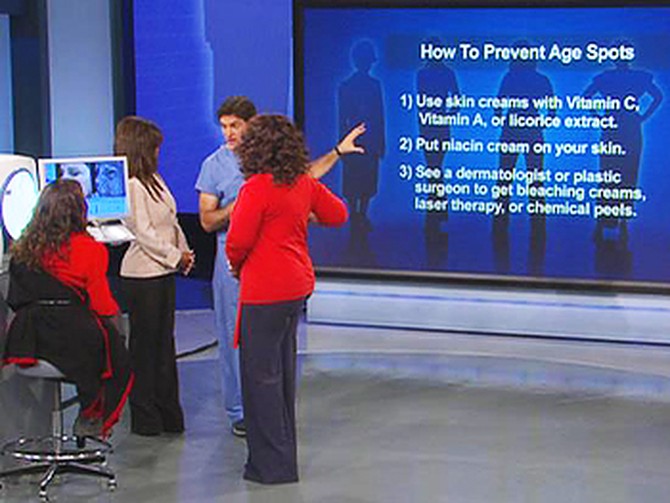
Besides using a sunscreen that is right for your needs, Dr. Oz says there are three other things you need to do to make sure your skin is beautiful.
The first key is making sure you get plenty of vitamins A, C and E—through diet and nutrient-rich creams. "Those are the key antioxidant vitamins. But they're also important, especially vitamin A, because they block some of the bad things happening underneath," he says. "And they help rejuvenate—turn on cells that make more collagen, make more elastin—to give you that bounciness that you want."
Dr. Evans says vitamin A is especially important for healthy skin. "It can make real transitions in the beginning. In fact, some of the damage you've already done—it can turn back the clock," she says. "You see it in retinol forms. Pretty much anything like a retinyl or retinoic acid or retin is a form of vitamin A."
Another nutrient you need is niacin, which prevents melanin from reaching the skin and reduces the production of the staining compound. Dr. Oz says you can also use natural licorice extract to slow the creation of melanin.
The third key part of a healthy skin routine is exfoliation. "Sun spots are stuck in the skin, so if you stop making new ones, your body rubs off the old levels," Dr. Oz says. "That's basically what exfoliation is, but you do it naturally. We shed dozens of pounds of skin a year. ... And your body will shed those sun-damaged areas."
The first key is making sure you get plenty of vitamins A, C and E—through diet and nutrient-rich creams. "Those are the key antioxidant vitamins. But they're also important, especially vitamin A, because they block some of the bad things happening underneath," he says. "And they help rejuvenate—turn on cells that make more collagen, make more elastin—to give you that bounciness that you want."
Dr. Evans says vitamin A is especially important for healthy skin. "It can make real transitions in the beginning. In fact, some of the damage you've already done—it can turn back the clock," she says. "You see it in retinol forms. Pretty much anything like a retinyl or retinoic acid or retin is a form of vitamin A."
Another nutrient you need is niacin, which prevents melanin from reaching the skin and reduces the production of the staining compound. Dr. Oz says you can also use natural licorice extract to slow the creation of melanin.
The third key part of a healthy skin routine is exfoliation. "Sun spots are stuck in the skin, so if you stop making new ones, your body rubs off the old levels," Dr. Oz says. "That's basically what exfoliation is, but you do it naturally. We shed dozens of pounds of skin a year. ... And your body will shed those sun-damaged areas."

Like 50 million other people, Crystal sufferers from adult acne. It's so bad that on particularly bad days, she says, she has canceled plans with friends and not gone to jobs she applied for.
Crystal's cleaning routine starts with scrubbing off all the makeup she uses to cover her acne. She uses a harsh antibacterial soap. "I hope it kills bacteria that causes pimples," she says. Next, she uses witch hazel to remove the last traces of makeup.
Next, Crystal applies a heavy moisturizer to combat dryness and premature wrinkles. Then, she applies an antibiotic ointment. "I coat each pimple heavily," she says.
But that's not all. Crystal says she also uses a bleaching product every two weeks to clear her skin of brown blotches. "It burns really badly, but it does work," she says.
"I'm embarrassed to say that because I wish I was more secure to just be who I am," she says. "But I just feel like it's probably the most disgusting face in the world."
Crystal's cleaning routine starts with scrubbing off all the makeup she uses to cover her acne. She uses a harsh antibacterial soap. "I hope it kills bacteria that causes pimples," she says. Next, she uses witch hazel to remove the last traces of makeup.
Next, Crystal applies a heavy moisturizer to combat dryness and premature wrinkles. Then, she applies an antibiotic ointment. "I coat each pimple heavily," she says.
But that's not all. Crystal says she also uses a bleaching product every two weeks to clear her skin of brown blotches. "It burns really badly, but it does work," she says.
"I'm embarrassed to say that because I wish I was more secure to just be who I am," she says. "But I just feel like it's probably the most disgusting face in the world."
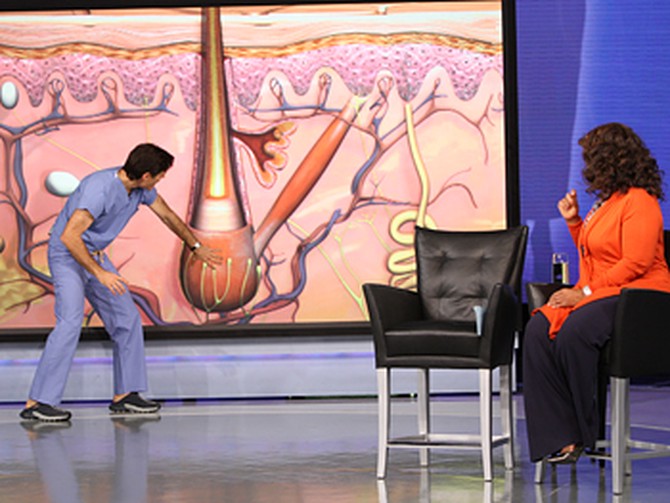
Before diagnosing Crystal, Dr. Oz explains what causes acne.
Hair grows from a deep follicle where it also has a blood supply. "And sometimes the sebum, the oil that normally coats our skin, comes out from down below and is supposed to come out of this hole," he says. "But if you overgrow this, you clog it and then this stuff builds up and becomes pus."
That pus increases, raising the skin and becomes a pimple.
Now, if you're thinking about popping a zit, Dr. Oz says to think twice—especially if it's in the triangle from the tip of your nose to the edges of your lips. "This is called the triangle of death," he says. "When you squeeze a pimple in here, that pus doesn't have to come up. Instead of the pus going [out], it can go back down into those blood vessels. And guess where they go? They go to your brain."
There are other cosmetic dangers too. "You can actually cause more scarring, more damage," Dr. Evans says. "In some cases, you get a dark spot there."
Hair grows from a deep follicle where it also has a blood supply. "And sometimes the sebum, the oil that normally coats our skin, comes out from down below and is supposed to come out of this hole," he says. "But if you overgrow this, you clog it and then this stuff builds up and becomes pus."
That pus increases, raising the skin and becomes a pimple.
Now, if you're thinking about popping a zit, Dr. Oz says to think twice—especially if it's in the triangle from the tip of your nose to the edges of your lips. "This is called the triangle of death," he says. "When you squeeze a pimple in here, that pus doesn't have to come up. Instead of the pus going [out], it can go back down into those blood vessels. And guess where they go? They go to your brain."
There are other cosmetic dangers too. "You can actually cause more scarring, more damage," Dr. Evans says. "In some cases, you get a dark spot there."
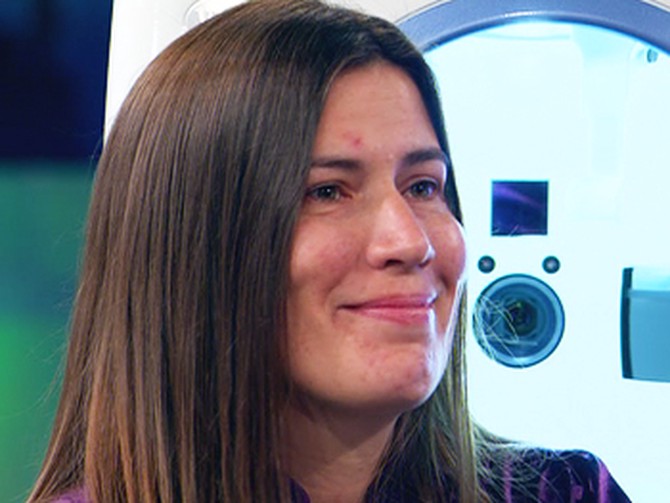
Crystal has never been to a dermatologist before. Using the Visia Complexion Analysis System, Dr. Evans inspects Crystal's skin.
At the higher level on Crystal's epidermis, Dr. Evans finds dark marks. Going deeper, she finds lots of red marks on Crystal's dermis. "You see redness in these areas here," she says. "[That is] all the acne that's kind of underneath the skin that will be coming to the surface.
Dr. Evans also finds some evidence of sun damage on Crystal's skin, even though Crystal wears sunscreen and stays out of the sun. "[Acne] breaks down your defense to deal with the sun," she says. "If you have acne, you also need to use sunscreen. Not a moisturizing one that will cause you to break out more, but a gel one."
Finally, Dr. Evans suggests that Crystal use oil-free makeup and moisturizers. "Get a simple cleanser that is not too harsh and doesn't dry out your face and cause you to produce too much oil," she says.
At the higher level on Crystal's epidermis, Dr. Evans finds dark marks. Going deeper, she finds lots of red marks on Crystal's dermis. "You see redness in these areas here," she says. "[That is] all the acne that's kind of underneath the skin that will be coming to the surface.
Dr. Evans also finds some evidence of sun damage on Crystal's skin, even though Crystal wears sunscreen and stays out of the sun. "[Acne] breaks down your defense to deal with the sun," she says. "If you have acne, you also need to use sunscreen. Not a moisturizing one that will cause you to break out more, but a gel one."
Finally, Dr. Evans suggests that Crystal use oil-free makeup and moisturizers. "Get a simple cleanser that is not too harsh and doesn't dry out your face and cause you to produce too much oil," she says.
Keep Reading
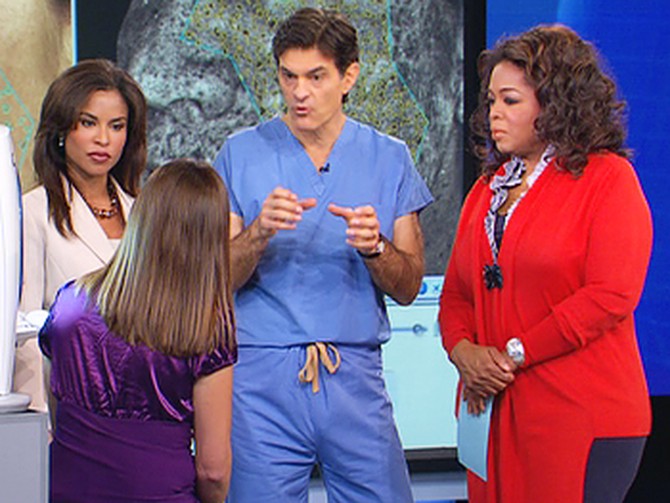
Skin products don't have to be expensive, Dr. Oz says. "Most of the products we recommend are $10 or $12. Don't go for the marketing blitz," he says. "If there's retin in it, it has a vitamin A compound that we like. 'Ascorbic acid' is the word for vitamin C, and 'tocopherol' is the word for vitamin E. Those are the key ingredients to nourish your skin."
To ensure healthy skin, Dr. Oz says you need to eat right. "Avocados, soybeans and nuts all contain biotin, an essential vitamin for healthy skin," he says. "A lack of biotin has been known to cause dermatitis—swollen, itchy or extremely dry skin."
Add salmon for skin elasticity, pomegranates to help produce more collagen and keep the skin looking young, and plenty of tomatoes. "Studies have shown that lycopene in tomatoes can protect your skin from aging by preventing sunburns," Dr. Oz says. "The most important thing with tomatoes is to make sure they're with oil. If you heat them up and mix them with oil, that's called pasta sauce."
To ensure healthy skin, Dr. Oz says you need to eat right. "Avocados, soybeans and nuts all contain biotin, an essential vitamin for healthy skin," he says. "A lack of biotin has been known to cause dermatitis—swollen, itchy or extremely dry skin."
Add salmon for skin elasticity, pomegranates to help produce more collagen and keep the skin looking young, and plenty of tomatoes. "Studies have shown that lycopene in tomatoes can protect your skin from aging by preventing sunburns," Dr. Oz says. "The most important thing with tomatoes is to make sure they're with oil. If you heat them up and mix them with oil, that's called pasta sauce."
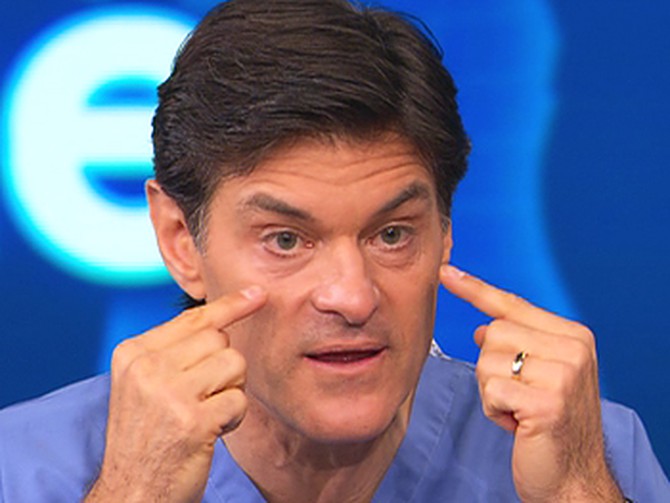
Many women complain about puffy eyes—even Oprah. Dr. Oz says undereye bags can be short-term or long-term. The short-term bags are caused by lack of sleep. "If you haven't slept all that long, that means you're stressed out," he says. "You start to swell because your body feels stress. Your ankles swell, and so does the tissue under your eyes."
Everyone has natural fat around the eyes, Dr. Oz explains. "It cushions the eye so if you get hit, it protects the eye," he says. When people develop long-term undereye bags, it's usually because that fat begins to herniate. "The fat oozes out and starts to stick [under the eyes] because of gravity."
If your undereye bags come and go when you're sleep deprived, eye creams or cucumber slices can help. But Dr. Oz says the only true solution for long-term bags is plastic surgery. "Eyes are the first place you really see aging, and it's probably the safest [invasive] plastic procedure that there is," he says. "But I don't want you all running out to get it, because I think across the board women are more worried about the bags under their eyes than the men who love them are."
Everyone has natural fat around the eyes, Dr. Oz explains. "It cushions the eye so if you get hit, it protects the eye," he says. When people develop long-term undereye bags, it's usually because that fat begins to herniate. "The fat oozes out and starts to stick [under the eyes] because of gravity."
If your undereye bags come and go when you're sleep deprived, eye creams or cucumber slices can help. But Dr. Oz says the only true solution for long-term bags is plastic surgery. "Eyes are the first place you really see aging, and it's probably the safest [invasive] plastic procedure that there is," he says. "But I don't want you all running out to get it, because I think across the board women are more worried about the bags under their eyes than the men who love them are."
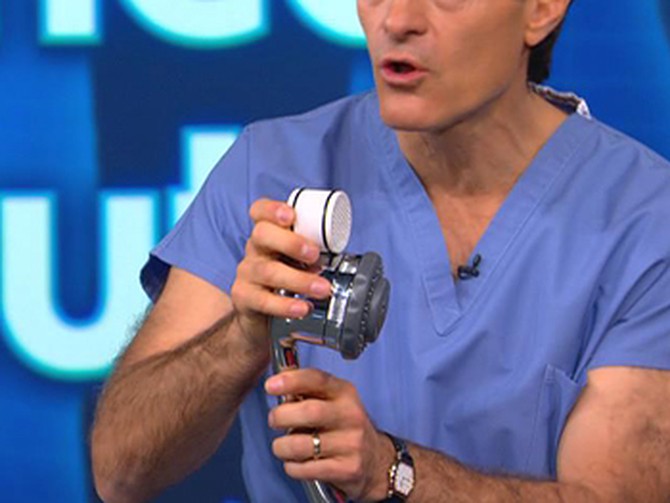
Your outer beauty often reflects your inner health, and Dr. Oz says that's especially true when it comes to hair. He recommends a 10-second hair test to see if yours is healthy. "Grab some hair, about as much as you would put in a straw. Grab it at the very bottom, right where it comes off the scalp, and pull up," he says. "Now look at how many hairs you have in your hand. A straw amount of hair is about 60 hairs. If you're pulling out more than six hairs, then you're starting to lose hair a little rapidly."
People think baldness is strictly a male problem, but 40 percent of women suffer from hair loss. "You've got to treat [your hair] like a fine silk blouse that got wet," Dr. Oz says. "If you're blow-drying your blouse that got a little wet or if you're combing it backward over and over again, or if you're too rough with it, it begins to fray. Your hair has to be dealt with extraordinarily gently."
Dr. Oz says the best thing you can do for your hair costs less than 9 cents a day. "Get a charcoal filter and put it in your showerhead," he says. When chlorine is present in the water in your shower, it can dry you up a lot. A filter is an easy fix.
He also suggests covering your hair when you're in a lot of sunlight. "The sun actually fries the hair and will take away that lovely body it's supposed to have." Finally, only shampoo when your hair is dirty—not every day.
People think baldness is strictly a male problem, but 40 percent of women suffer from hair loss. "You've got to treat [your hair] like a fine silk blouse that got wet," Dr. Oz says. "If you're blow-drying your blouse that got a little wet or if you're combing it backward over and over again, or if you're too rough with it, it begins to fray. Your hair has to be dealt with extraordinarily gently."
Dr. Oz says the best thing you can do for your hair costs less than 9 cents a day. "Get a charcoal filter and put it in your showerhead," he says. When chlorine is present in the water in your shower, it can dry you up a lot. A filter is an easy fix.
He also suggests covering your hair when you're in a lot of sunlight. "The sun actually fries the hair and will take away that lovely body it's supposed to have." Finally, only shampoo when your hair is dirty—not every day.

Six weeks ago, Melissa had a full head of hair. But in the last month and a half, she says her hair has started falling out all the time. "I have no explanation for it," Melissa says. "It could be stress, but it falls out in clumps when I shower and after my shower when I comb my hair. It's just all day long. I can pull hairs out at any given time."
Melissa says she's had no major illnesses lately, so Dr. Oz asked her to have a Biophysical 250 blood test. The test showed that Melissa had elevated markers of inflammation and allergies. "Something's going on in your life that is make you allergic, whether it's an environmental product, or you're putting something new in your hair or different food," Dr. Oz says.
The tests also showed that Melissa may have a small tumor in her brain. "What the blood test tells us is that this gland in her brain is actually making more of a hormone than it's supposed to make," Dr. Oz says. "It doesn't mean there's a tumor. It means that there's something going on."
When you notice something abnormal happening with your body, the smartest thing you can do is to speak up, Dr. Oz says. "This is not about vanity. This is about life."
Melissa says she's had no major illnesses lately, so Dr. Oz asked her to have a Biophysical 250 blood test. The test showed that Melissa had elevated markers of inflammation and allergies. "Something's going on in your life that is make you allergic, whether it's an environmental product, or you're putting something new in your hair or different food," Dr. Oz says.
The tests also showed that Melissa may have a small tumor in her brain. "What the blood test tells us is that this gland in her brain is actually making more of a hormone than it's supposed to make," Dr. Oz says. "It doesn't mean there's a tumor. It means that there's something going on."
When you notice something abnormal happening with your body, the smartest thing you can do is to speak up, Dr. Oz says. "This is not about vanity. This is about life."

Feet are another part of the body that many women hide. Geri is constantly embarrassed by her feet, which she says have been problematic for about two years. "When I would polish my toes, they would burn me. I would take [the polish] off, and notice that my toenails were yellowing underneath," she says. "It seemed like it was spreading, and it's just gotten worse over time." Geri says she has used over-the-counter treatments that her pharmacist gave her, but nothing has helped.
To treat fungal infections of the foot, Dr. Oz says you have to take a pill by mouth. "That pill does have one side effect: It can cause liver failure. So we don't use it a lot, and you've got to be careful about using it, because it doesn't save your life, right? No one dies from toe fungus."
To avoid foot fungus in the first place, keep your toes dry and try to expose them to the sun, Dr. Oz says. Many people who think they have fungus actually just have an infection around the nail. Dr. Oz recommends soaking your foot in vinegar or tea tree oil to cure those infections.
To treat fungal infections of the foot, Dr. Oz says you have to take a pill by mouth. "That pill does have one side effect: It can cause liver failure. So we don't use it a lot, and you've got to be careful about using it, because it doesn't save your life, right? No one dies from toe fungus."
To avoid foot fungus in the first place, keep your toes dry and try to expose them to the sun, Dr. Oz says. Many people who think they have fungus actually just have an infection around the nail. Dr. Oz recommends soaking your foot in vinegar or tea tree oil to cure those infections.
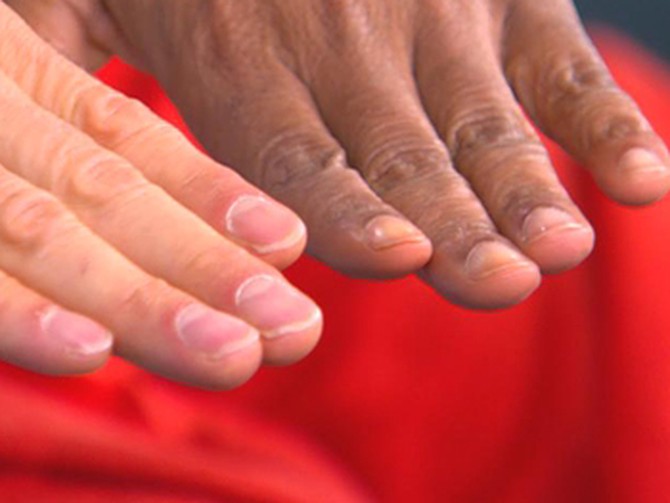
There are easy ways to see how your body developed even before you were born, Dr. Oz says. One quick test is to take a look at your index and ring finger. If your index finger is shorter than your fourth finger, it means you had a lot of testosterone in utero. If your index finger is about the same height as your fourth finger, you probably had more estrogen in the womb. "I only point that out because these are the kinds of simple things that we look to to see how you developed," Dr. Oz says. "It's a pretty cool little way of examining our bodies."
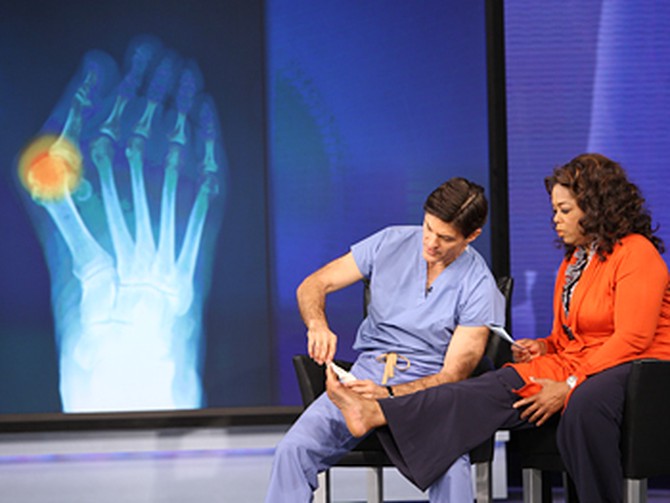
Oprah says her bunions were outed when the paparazzi got a picture of her without shoes on, and she wants to know what causes them. Dr. Oz says about 90 percent of bunions are hereditary. If your foot has bones that naturally splay out, and you put them in a high heel, squeezing the toes together into a narrow toe box, the splayed-out bones continue to go in the wrong direction. "It's a recipe for bunions," he says.
If you have bunions, Dr. Oz says there's only one indication of whether it needs to be operated on. "Pain, pain, and pain. If you don't have pain, you're not operating on them," he says.
Fixing a bunion requires shaving off a bit of the splayed-out bone, cutting the bone below the bunion and pushing in the splayed-out bone to straighten the toe. "This is not an operation you pop back on," Dr. Oz says. "Our feet are critically important to our well-being."
If you have bunions, Dr. Oz says there's only one indication of whether it needs to be operated on. "Pain, pain, and pain. If you don't have pain, you're not operating on them," he says.
Fixing a bunion requires shaving off a bit of the splayed-out bone, cutting the bone below the bunion and pushing in the splayed-out bone to straighten the toe. "This is not an operation you pop back on," Dr. Oz says. "Our feet are critically important to our well-being."
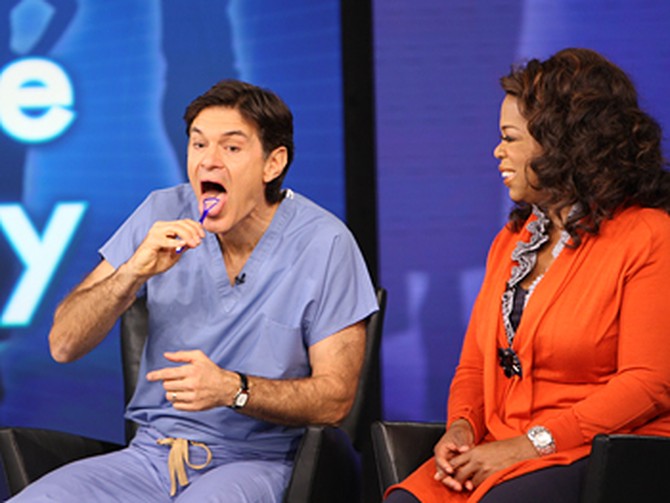
One of the largest contributors to people feeling unattractive has nothing to do with their looks, but their breath. Dr. Oz says it can often be a sign of a serious health problem, but many people don't know they have bad breath since it's hard to smell yourself. "If someone comes up to you and gives you a mouth freshener, they're telling you you have bad breath," he says. "They're not being kind."
Bad breath is often caused by stomach issues—bacteria or foods that don't agree with you. "Another common cause, besides gingivitis, is your tongue," Dr. Oz says. He suggests buying a tongue scraper to clean off bacteria and fight bad breath. "Don't ignore bad breath. Something is going on in there, which is why you've got that stench."
Bad breath is often caused by stomach issues—bacteria or foods that don't agree with you. "Another common cause, besides gingivitis, is your tongue," Dr. Oz says. He suggests buying a tongue scraper to clean off bacteria and fight bad breath. "Don't ignore bad breath. Something is going on in there, which is why you've got that stench."

If there's one thing women want a magic pill for, it's cellulite. Dr. Oz is here with some bad news. "You can't cure it. There's nothing you can do about it," he says.
Cellulite is actually a collection of fat cells next to arteries that get larger when they take in extra nutrients, which increase as you age. "As those molecules of fat begin to accumulate in the individual fat cells, those cells become nice and big and plump," Dr. Oz says. As the cells grow, they suck more blood supply toward them, which helps them to keep growing. "They blow up like individual balloons."
Dr. Oz's beauty school...your guide to inner and outer beauty.
Get more health advice from Dr. Oz!
Cellulite is actually a collection of fat cells next to arteries that get larger when they take in extra nutrients, which increase as you age. "As those molecules of fat begin to accumulate in the individual fat cells, those cells become nice and big and plump," Dr. Oz says. As the cells grow, they suck more blood supply toward them, which helps them to keep growing. "They blow up like individual balloons."
Dr. Oz's beauty school...your guide to inner and outer beauty.
Get more health advice from Dr. Oz!
Published 11/11/2008
As a reminder, always consult your doctor for medical advice and treatment before starting any program.




